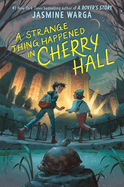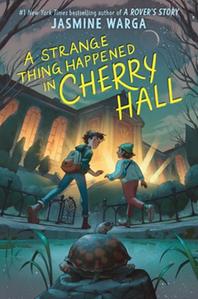
 In her delightfully offbeat middle-grade mystery, A Strange Thing Happened in Cherry Hall, Newbery Honor-winning author Jasmine Warga (Other Words for Home; A Rover's Story) gracefully interlaces a middle school coming-of-age tale with an art heist whodunit. A painting has gone missing at the museum where almost-12-year-old Rami Ahmed's mother works as cleaning crew supervisor. She is under suspicion, and Rami thinks that if he can crack the case, he'll keep her out of jail.
In her delightfully offbeat middle-grade mystery, A Strange Thing Happened in Cherry Hall, Newbery Honor-winning author Jasmine Warga (Other Words for Home; A Rover's Story) gracefully interlaces a middle school coming-of-age tale with an art heist whodunit. A painting has gone missing at the museum where almost-12-year-old Rami Ahmed's mother works as cleaning crew supervisor. She is under suspicion, and Rami thinks that if he can crack the case, he'll keep her out of jail.
Middle school has gotten off to a rough start for Rami, who sometimes wonders if things would be better for him "socially" if his name ended with a "y" (like his former friends Henry and Matty) instead of an "i." Rami, whose parents were born in Lebanon, is also self-conscious, which makes it difficult to connect with people: "He... always found that initial approach so awkward.... How do you know if someone actually wants you to say hi?" Loud, confident Veda, whose parents were born in India, ignores the awkwardness; she and the rest of her lunch table took him in "after everything bad went down with his old friends." Now, Veda gets right to business helping Rami solve the art theft. Adding to the mystery, Rami has repeatedly seen a girl with bare feet hovering above the floor in Cherry Hall, the room where the painting had hung. Once he gets over his initial shock, he deduces she must have something to do with the missing painting.
A Strange Thing Happened in Cherry Hall is charmingly reminiscent of early- and mid-20th century novels like Half Magic by Edward Eager and Five Children and It by E. Nesbit, as well as those by more contemporary authors like Kate DiCamillo and Erin Entrada Kelly. Matt Rockefeller's black-and-white illustrations at the open and close of the book set the scene with elegant images of the museum and its grounds. A portrait wall captures each character's essence with simple, deft strokes. A somewhat omniscient character named Agatha pops up throughout the book, in repeating spot art as well as in "person." She is a curious, art-loving turtle who lives in the garden behind the museum and sees more than most of the humans. Of course, "this is a story with lots of mysterious and strange things, but it is not a story that features a turtle who can speak with humans," so Agatha is able to contribute to solving the case only indirectly. Warga's novel, like the floating girl, contains a delicious "multitude of mysteries." --Emilie Coulter, freelance writer and editor
Shelf Talker: In this Newbery Honor-winning author's delightfully offbeat mystery, a socially struggling sixth grader learns to connect with people as he attempts to solve the case of a missing museum painting.

